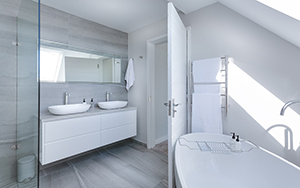A well-designed, beautiful bathroom is a top priority for homeowners, so an appealing and properly installed bathroom is a worthwhile reason to hire a plumber. A survey of 2,000 property owners, by Gocompare.com, highlighted that ‘aspects of bathrooms feature high on the list of must-haves - such as a bathtub (57 per cent) and a separate shower cubicle (47 per cent)’, as does having at least two toilets (45%) and an en-suite bathroom (34 per cent).
Although the design of a bathroom is important, improperly installed bathroom features and water systems can cause water contamination and flooding, leading to costly repairs. Homeowners want reassurance that quality products have been used in their bathroom, which will continue to give years of service without causing problems – but how do you ensure this is the case?
One of your first priorities when designing a bathroom should be ensuring any water systems or fittings installed meet the requirements of the Water Supply (Water Fittings) Regulations and Scottish Water Byelaws.
There is a legal duty for all users, owners or occupiers and anyone who installs water systems to ensure they are installed and used in accordance with these regulations. At first glance, the regulations may seem to be complicated, but most of the requirements are simply good plumbing practice, which can prevent problems occurring and protect your customers. So, make sure you understand all the requirements you need to meet before starting any work.
Whilst not the most glamorous aspect of a new bathroom, these regulations aim to ensure the safety and efficiency of the water supply, ensuring it is not misused or wasted and, most importantly, is installed to prevent the contamination of drinking water. In line with these regulations, here’s what you need to know about ensuring your bathroom design is compliant, resulting in healthy and happy homeowners. 
Check your products comply with the regulations:
Beautiful products that homeowners will fall in love with are of course important, but there is no point in investing in the flashiest fitting if it doesn’t comply with water fittings regulations. The regulations require that water fittings including WCs, taps, pipes and showers are of an appropriate quality and standard. Products must be thoroughly tested against performance standards to ensure they won’t contaminate or leak.
Installation of fittings which fail to comply with the regulations could result in costly plumbing alterations enforced by the local water company, or in some cases, prosecution.
Furthermore, untested water fittings may contaminate the drinking water supply due to inappropriate materials or installation method used.
Make sure that any water fittings used in a new bathroom design, such as taps and showers, have been tested to fully comply with the regulations. For example, the ‘WRAS Approved’ logo on a product’s packaging confirms a product has been tested and a full list of approved products is available on the online directory at www.wras.co.uk.
Notify your local water company:
Many types of plumbing work done on both new and existing premises need additional approval before the work can begin. Where you have applied for a new connection, many water companies integrate notification in the application process. Failure to notify the water supplier or comply with the regulations can result in extra cost to amend any non-compliant work, delay a new connection and risk prosecution.
Many interior design trend-spotters have highlighted large, freestanding baths as being increasingly popular, especially in more luxurious settings. A particularly large bath may well require notification with the water company i.e. a bath with a capacity above 230 litres.
You can find out exactly which plumbing modifications require specific permission online at www.wras.co.uk/notification.
Prioritise safety over style:
A stylish bathroom may be of interest to most homeowners, but there isn’t any benefit in creating something beautiful if it isn’t safe to use. Trendy pieces such as minimalist walk-in showers and flexible shower hoses may be an enviable finishing touch, but they need to be installed with caution. To ensure shower hoses cannot trail into water in the bottom of the shower or bath, or reach a WC or bidet, which could result in contamination to the drinking water supply, make sure that any flexible hoses are suitably constrained, or simply fit a shorter hose. New trends are likely to consider style over substance, so be sure to check that any water fittings comply with the relevant regulations before installing them.
Choose water-efficient products:
Whether the home has a water meter or not, saving water saves the homeowner money in household energy and water bills, as well as helping to save the environment. Consider using straightforward and inexpensive devices such as water-efficient taps, flushes and shower heads, which can all reduce water waste.
For new properties, there may also be financial incentives for developers from your local water company, where water efficient products are used. Keep an eye out for the Water Label on products, as this helps to identify those that can help to decrease water usage – find out more information at www.europeanwaterlabel.eu. This is particularly worthwhile when planning a bathroom, as it means owners won’t need to switch out fittings for more efficient options in the future.
WaterSafe have just developed some useful advice for developers to help make homes more efficient. https://www.watersafe.org.uk/advice/information-for-developers/
Complying with the water regulations is in your interest, because correctly designed and installed plumbing systems are safe, robust and efficient. What’s more, you may risk a criminal prosecution and water company enforcement which could require alterations, at your own cost, to make your work comply.
Visit the WRAS website (www.wras.co.uk) for further advice and guidance.

Add new comment